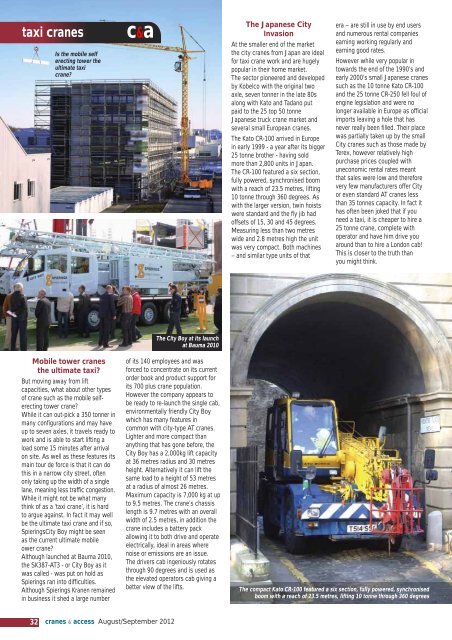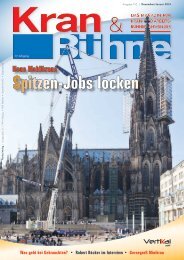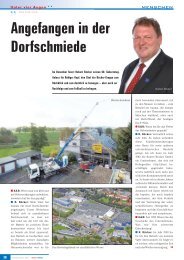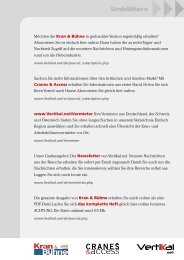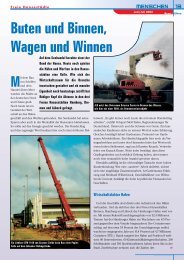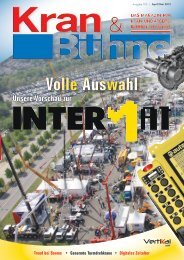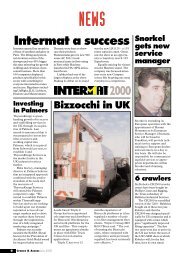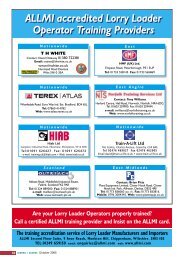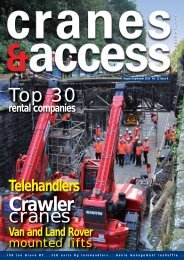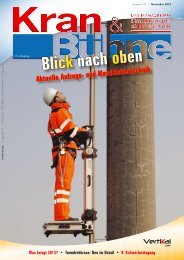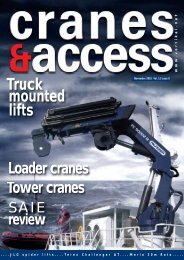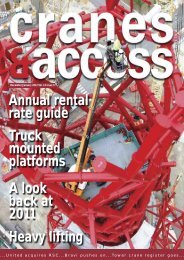Truck mounted lifts Taxi cranes Top 30 rental companies - Vertikal.net
Truck mounted lifts Taxi cranes Top 30 rental companies - Vertikal.net
Truck mounted lifts Taxi cranes Top 30 rental companies - Vertikal.net
You also want an ePaper? Increase the reach of your titles
YUMPU automatically turns print PDFs into web optimized ePapers that Google loves.
taxi <strong>cranes</strong> c&a<br />
Is the mobile self<br />
erecting tower the<br />
ultimate taxi<br />
crane?<br />
Mobile tower <strong>cranes</strong><br />
the ultimate taxi?<br />
But moving away from lift<br />
capacities, what about other types<br />
of crane such as the mobile selferecting<br />
tower crane?<br />
While it can out-pick a 350 tonner in<br />
many configurations and may have<br />
up to seven axles, it travels ready to<br />
work and is able to start lifting a<br />
load some 15 minutes after arrival<br />
on site. As well as these features its<br />
main tour de force is that it can do<br />
this in a narrow city street, often<br />
only taking up the width of a single<br />
lane, meaning less traffic congestion.<br />
While it might not be what many<br />
think of as a ‘taxi crane’, it is hard<br />
to argue against. In fact it may well<br />
be the ultimate taxi crane and if so,<br />
SpieringsCity Boy might be seen<br />
as the current ultimate mobile<br />
ower crane?<br />
Although launched at Bauma 2010,<br />
the SK387-AT3 - or City Boy as it<br />
was called - was put on hold as<br />
Spierings ran into difficulties.<br />
Although Spierings Kranen remained<br />
in business it shed a large number<br />
32 <strong>cranes</strong> & access August/September 2012<br />
The City Boy at its launch<br />
at Bauma 2010<br />
of its 140 employees and was<br />
forced to concentrate on its current<br />
order book and product support for<br />
its 700 plus crane population.<br />
However the company appears to<br />
be ready to re-launch the single cab,<br />
environmentally friendly City Boy<br />
which has many features in<br />
common with city-type AT <strong>cranes</strong>.<br />
Lighter and more compact than<br />
anything that has gone before, the<br />
City Boy has a 2,000kg lift capacity<br />
at 36 metres radius and <strong>30</strong> metres<br />
height. Alternatively it can lift the<br />
same load to a height of 53 metres<br />
at a radius of almost 26 metres.<br />
Maximum capacity is 7,000 kg at up<br />
to 9.5 metres. The crane’s chassis<br />
length is 9.7 metres with an overall<br />
width of 2.5 metres, in addition the<br />
crane includes a battery pack<br />
allowing it to both drive and operate<br />
electrically, ideal in areas where<br />
noise or emissions are an issue.<br />
The drivers cab ingeniously rotates<br />
through 90 degrees and is used as<br />
the elevated operators cab giving a<br />
better view of the <strong>lifts</strong>.<br />
The Japanese City<br />
Invasion<br />
At the smaller end of the market<br />
the city <strong>cranes</strong> from Japan are ideal<br />
for taxi crane work and are hugely<br />
popular in their home market.<br />
The sector pioneered and developed<br />
by Kobelco with the original two<br />
axle, seven tonner in the late 80s<br />
along with Kato and Tadano put<br />
paid to the 25 top 50 tonne<br />
Japanese truck crane market and<br />
several small European <strong>cranes</strong>.<br />
The Kato CR-100 arrived in Europe<br />
in early 1999 - a year after its bigger<br />
25 tonne brother - having sold<br />
more than 2,800 units in Japan.<br />
The CR-100 featured a six section,<br />
fully powered, synchronised boom<br />
with a reach of 23.5 metres, lifting<br />
10 tonne through 360 degrees. As<br />
with the larger version, twin hoists<br />
were standard and the fly jib had<br />
offsets of 15, <strong>30</strong> and 45 degrees.<br />
Measuring less than two metres<br />
wide and 2.8 metres high the unit<br />
was very compact. Both machines<br />
– and similar type units of that<br />
era – are still in use by end users<br />
and numerous <strong>rental</strong> <strong>companies</strong><br />
earning working regularly and<br />
earning good rates.<br />
However while very popular in<br />
towards the end of the 1990’s and<br />
early 2000’s small Japanese <strong>cranes</strong><br />
such as the 10 tonne Kato CR-100<br />
and the 25 tonne CR-250 fell foul of<br />
engine legislation and were no<br />
longer available in Europe as official<br />
imports leaving a hole that has<br />
never really been filled. Their place<br />
was partially taken up by the small<br />
City <strong>cranes</strong> such as those made by<br />
Terex, however relatively high<br />
purchase prices coupled with<br />
uneconomic <strong>rental</strong> rates meant<br />
that sales were low and therefore<br />
very few manufacturers offer City<br />
or even standard AT <strong>cranes</strong> less<br />
than 35 tonnes capacity. In fact it<br />
has often been joked that if you<br />
need a taxi, it is cheaper to hire a<br />
25 tonne crane, complete with<br />
operator and have him drive you<br />
around than to hire a London cab!<br />
This is closer to the truth than<br />
you might think.<br />
The compact Kato CR-100 featured a six section, fully powered, synchronised<br />
boom with a reach of 23.5 metres, lifting 10 tonne through 360 degrees


